Influence of Microstructure on Dynamic Mechanical Behavior and Damage Evolution of Frozen–Thawed Sandstone Using Computed Tomography
Abstract
:1. Introduction
2. Materials and Experimental Methods
2.1. Materials
2.2. Experimental Methods
2.2.1. F–T Tests
2.2.2. CT Scanning Tests
2.2.3. Static Tests
2.2.4. Dynamic Impact Tests
3. Experimental Results and Discussion
3.1. 3D Reconstruction
3.2. Effect of F–T on Microscopic Parameters
3.3. Effect of F–T on Fractal
3.4. Macroscopic Dynamic Mechanical Properties
3.5. Macro-Micro Properties Connection
4. Damage Evolution under F–T and Impact Loading
4.1. F–T Damage Dn
4.2. Damage Dm Evaluation
5. Conclusions
Author Contributions
Funding
Institutional Review Board Statement
Informed Consent Statement
Data Availability Statement
Conflicts of Interest
References
- Li, B.; Zhang, G.; Wang, G.; Qiao, J. Damage Evolution of Frozen-Thawed Granite Based on High-Resolution Computed Tomographic Scanning. Front. Earth Sci. 2022, 10, 1–12. [Google Scholar] [CrossRef]
- Park, J.; Hyun, C.U.; Park, H.D. Changes in microstructure and physical properties of rocks caused by artificial freeze–thaw action. Bull. Eng. Geol. Environ. 2015, 74, 555–565. [Google Scholar] [CrossRef]
- Wang, T.; Sun, Q.; Jia, H.; Ren, J.; Luo, T. Linking the mechanical properties of frozen sandstone to phase composition of pore water measured by LF-NMR at subzero temperatures. Bull. Eng. Geol. Environ. 2021, 80, 4501–4513. [Google Scholar] [CrossRef]
- Liu, D.; Pu, H.; Sha, Z.; Xu, J. Experimental study on dynamic tensile mechanical properties of sandstone under freeze—Thaw cycles. Coal Sci. Technol. 2022, 50, 60–67. [Google Scholar]
- Zhou, Z.; Yude, E.; Cai, X.; Zhang, J. Coupled Effects of Water and Low Temperature on Quasistatic and Dynamic Mechanical Behavior of Sandstone. Geofluids 2021, 2021, 1–12. [Google Scholar] [CrossRef]
- Sha, Z.; Pu, H.; Xu, J.; Ni, H.; Guo, S. Effects of Accumulated Damage on the Dynamic Properties of Coal Measures Sandstone. Minerals 2022, 12, 810. [Google Scholar] [CrossRef]
- Xu, J.; Pu, H.; Sha, Z. Mechanical behavior and decay model of the sandstone in Urumqi under coupling of freeze–thaw and dynamic loading. Bull. Eng. Geol. Environ. 2021, 80, 2963–2978. [Google Scholar] [CrossRef]
- Li, J.; Kaunda, R.B.; Zhou, K. Experimental investigations on the effects of ambient freeze-thaw cycling on dynamic properties and rock pore structure deterioration of sandstone. Cold Reg. Sci. Technol. 2018, 154, 133–141. [Google Scholar] [CrossRef]
- Liu, S.; Xu, J.; Liu, S.; Wang, P. Fractal study on the dynamic fracture of red sandstone after F-T cycles. Environ. Earth Sci. 2022, 81, 1–13. [Google Scholar] [CrossRef]
- Xu, J.; Pu, H.; Sha, Z. Dynamic Mechanical Behavior of the Frozen Red Sandstone under Coupling of Saturation and Impact Loading. Appl. Sci. 2022, 12, 7767. [Google Scholar] [CrossRef]
- Zhang, J.; Deng, H.; Deng, J.; Ke, B. Development of energy-based brittleness index for sandstone subjected to freeze-thaw cycles and impact loads. IEEE Access 2018, 6, 48522–48530. [Google Scholar] [CrossRef]
- Song, Y.; Yang, H.; Tan, H.; Ren, J.; Guo, X. Study on damage evolution characteristics of sandstone with different saturations in freeze-thaw environment. Chin. J. Rock Mech. Eng. 2021, 40, 1513–1524. [Google Scholar]
- Wu, N.; Liang, Z.Z.; Li, Y.C.; Li, H.; Li, W.R.; Zhang, M. Stress-dependent anisotropy index of strength and deformability of jointed rock mass: Insights from a numerical study. Bull. Eng. Geol. Environ. 2019, 78, 5905–5917. [Google Scholar] [CrossRef]
- Deprez, M.; De Kock, T.; De Schutter, G.; Cnudde, V. A review on freeze-thaw action and weathering of rocks. Earth Sci. Rev. 2020, 203, 103143. [Google Scholar] [CrossRef]
- Fang, Y.; Qiao, L.; Chen, X.; Yan, S.J.; Zhai, G.L.; Liang, Y.W. Experimental study of freezing-thawing cycles on sandstone in Yungang grottos. Yantu Lixue/Rock Soil Mech. 2014, 35, 2433–2442. [Google Scholar]
- Cheng, H.; Chen, H.; Cao, G.; Rong, C.; Yao, Z.; Cai, H. Damage mechanism of porous rock caused by moisture migration during freeze-thaw process and experimental verification. Chin. J. Rock Mech. Eng. 2020, 39, 1739–1749. [Google Scholar]
- Xu, J.; Pu, H.; Sha, Z. Effect of Freeze-Thaw Damage on the Physical, Mechanical, and Acoustic Behavior of Sandstone in Urumqi. Appl. Sci. 2022, 12, 7870. [Google Scholar] [CrossRef]
- De Kock, T.; Boone, M.A.; De Schryver, T.; Van Stappen, J.; Derluyn, H.; Masschaele, B.; De Schutter, G.; Cnudde, V. A pore-scale study of fracture dynamics in rock using X-ray micro-CT under ambient freeze-thaw cycling. Environ. Sci. Technol. 2015, 49, 2867–2874. [Google Scholar] [CrossRef]
- Yang, G.; Liu, H. Microstructure and Damage Mechanical Characteristic of Frozen Rock Based on CY Image Processing; Science Press: Beijing, China, 2016. [Google Scholar]
- Fan, L.F.; Fan, Y.D.; Xi, Y.; Gao, J.W. Spatial Failure Mode Analysis of Frozen Sandstone Under Uniaxial Compression Based on CT Technology. Rock Mech. Rock Eng. 2022, 55, 4123–4138. [Google Scholar] [CrossRef]
- Maji, V. An Experimental Investigation of Micro-and Macrocracking Mechanisms in Rocks by Freeze-Thaw Cycling. Ph.D. Thesis, University of Sussex, Falmer, East Sussex, UK, August 2021. [Google Scholar]
- Huang, S.; Cai, Y.; Liu, Y.; Liu, G. Experimental and Theoretical Study on Frost Deformation and Damage of Red Sandstones with Different Water Contents. Rock Mech. Rock Eng. 2021, 54, 4163–4181. [Google Scholar] [CrossRef]
- De Paepe, A.E.; Sierpowska, J.; Garcia-Gorro, C.; Martinez-Horta, S.; Perez-Perez, J.; Kulisevsky, J.; Rodriguez-Dechicha, N.; Vaquer, I.; Subira, S.; Calopa, M.; et al. Using µCT to investigate water migration during freeze-thaw experiments. J. Chem. Inf. Model. 2019, 53, 1689–1699. [Google Scholar]
- Deprez, M.; De Kock, T.; De Schutter, G.; Cnudde, V. Dynamic X-ray CT to monitor water distribution within porous building materials: A build-up towards frost-related experiments. 3rd Int. Conf. Tomogr. Mater. Struct. 2017, 203, 103143. [Google Scholar]
- Yang, H.; Liu, P.; Sun, B.; Yi, Z.; Wang, J.; Yue, Y. Study on damage mechanisms of the microstructure of sandy conglomerate at Maijishan grottoes under freeze-thaw cycles. Chin. J. Rock Mech. Eng. 2021, 40, 545–555. [Google Scholar]
- ThermoFisher Scientific. Thermo Scientific Avizo Software 9, 2018; Volume 9.
- Chen, Y.; Huidong, C.; Ming, L.; Pu, H. Study on dynamic mechanical properties and failure mechanism of saturated coal-measure sandstone in open pit mine with damage under real-time low-temperature conditions. J. China Coal Soc. 2022, 47, 1168–1179. [Google Scholar]
- Gong, F.Q.; Si, X.F.; Li, X.B.; Wang, S.Y. Dynamic triaxial compression tests on sandstone at high strain rates and low confining pressures with split Hopkinson pressure bar. Int. J. Rock Mech. Min. Sci. 2019, 113, 211–219. [Google Scholar] [CrossRef]
- Wan, Y.; Chen, G.Q.; Sun, X.; Zhang, G.Z. Triaxial creep characteristics and damage model for red sandstone subjected to freeze-thaw cycles under different water contents. Chin. J. Geotech. Eng. 2021, 43, 1463–1472. [Google Scholar]
- Feng, S.; Zhou, Y.; Wang, Y.; Lei, M. Experimental research on the dynamic mechanical properties and damage characteristics of lightweight foamed concrete under impact loading. Int. J. Impact Eng. 2020, 140, 103558. [Google Scholar] [CrossRef]
- Ding, Z.; Li, X.; Tang, Q.; Jia, J. Study on correlation between fractal characteristics of pore distribution and strength of sandstone particles. Chin. J. Rock Mech. Eng. 2020, 39, 1787–1796. [Google Scholar]
- Liu, H.; Yang, G.; Yun, Y.; Lin, J.; Ye, W.; Zhang, H.; Zhang, Y. Investigation of Sandstone Mesostructure Damage Caused by Freeze-Thaw Cycles via CT Image Enhancement Technology. Adv. Civ. Eng. 2020, 2020, 1–13. [Google Scholar] [CrossRef]
- Khanlari, G.; Abdilor, Y. Influence of wet–dry, freeze–thaw, and heat–cool cycles on the physical and mechanical properties of Upper Red sandstones in central Iran. Bull. Eng. Geol. Environ. 2015, 74, 1287–1300. [Google Scholar] [CrossRef]
- Scherer, G.W. Crystallization in pores. Cem. Concr. Res. 1999, 29, 1347–1358. [Google Scholar] [CrossRef]
- Rempel, A.W. Formation of ice lenses and frost heave. J. Geophys. Res. Earth Surf. 2007, 112, 1–17. [Google Scholar] [CrossRef] [Green Version]
- Cuiying, Z.; Ning, L.; Zhen, L. Multifractal characteristics of pore structure of red beds soft rock at different saturations. J. Eng. Geol. 2020, 28, 1–9. [Google Scholar]
- Koniorczyk, M.; Bednarska, D. Influence of the mesopore’s diameter on the freezing kinetics of water. Microporous Mesoporous Mater. 2017, 250, 55–64. [Google Scholar] [CrossRef]
- Wang, Z.L.; Shi, H.; Wang, J.G. Mechanical Behavior and Damage Constitutive Model of Granite Under Coupling of Temperature and Dynamic Loading. Rock Mech. Rock Eng. 2018, 51, 3045–3059. [Google Scholar] [CrossRef]
- Zhou, J.; Chen, X. Stress-Strain Behavior and Statistical Continuous Damage Model of Cement Mortar under High Strain Rates. J. Mater. Civ. Eng. 2013, 25, 120–130. [Google Scholar] [CrossRef]

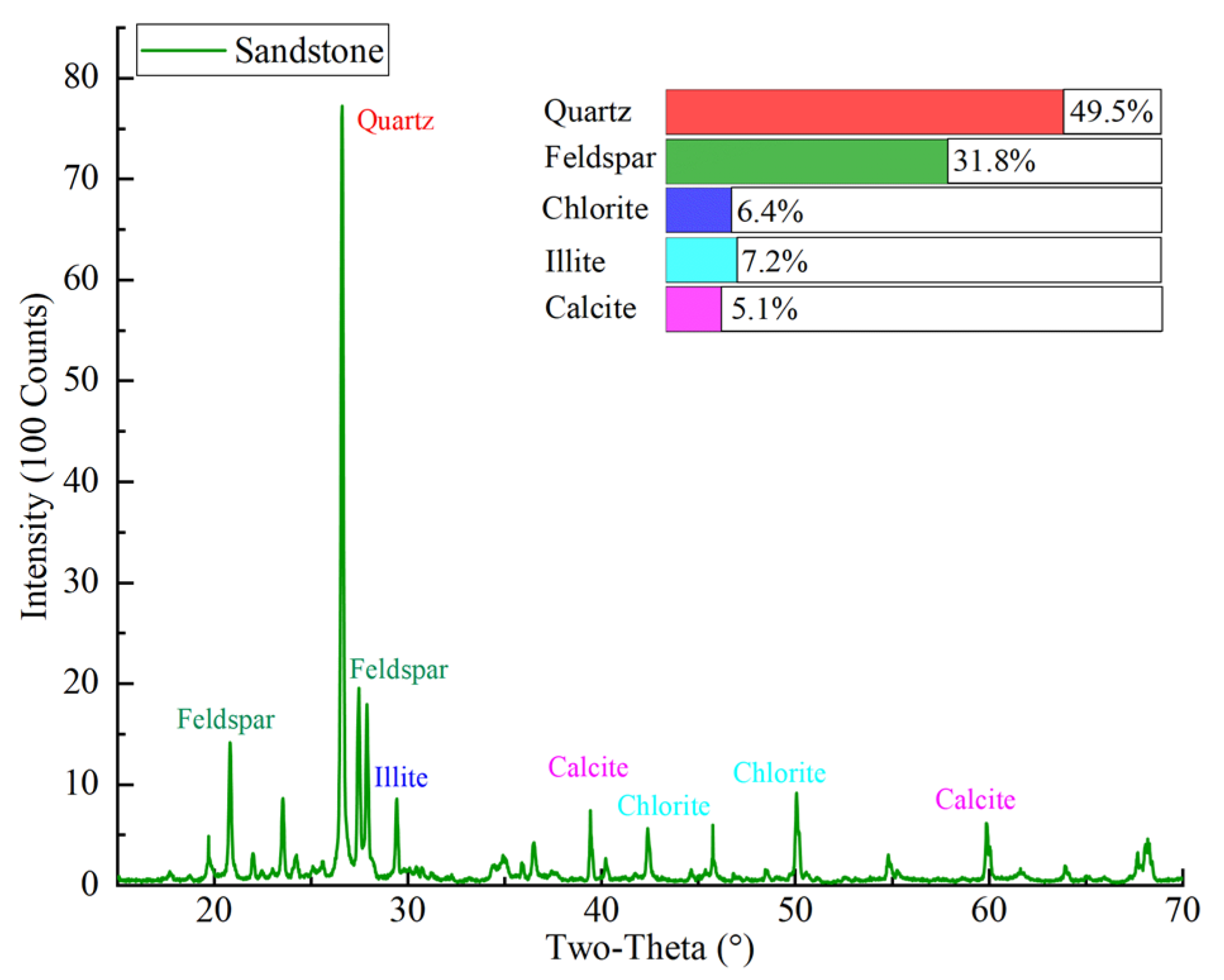

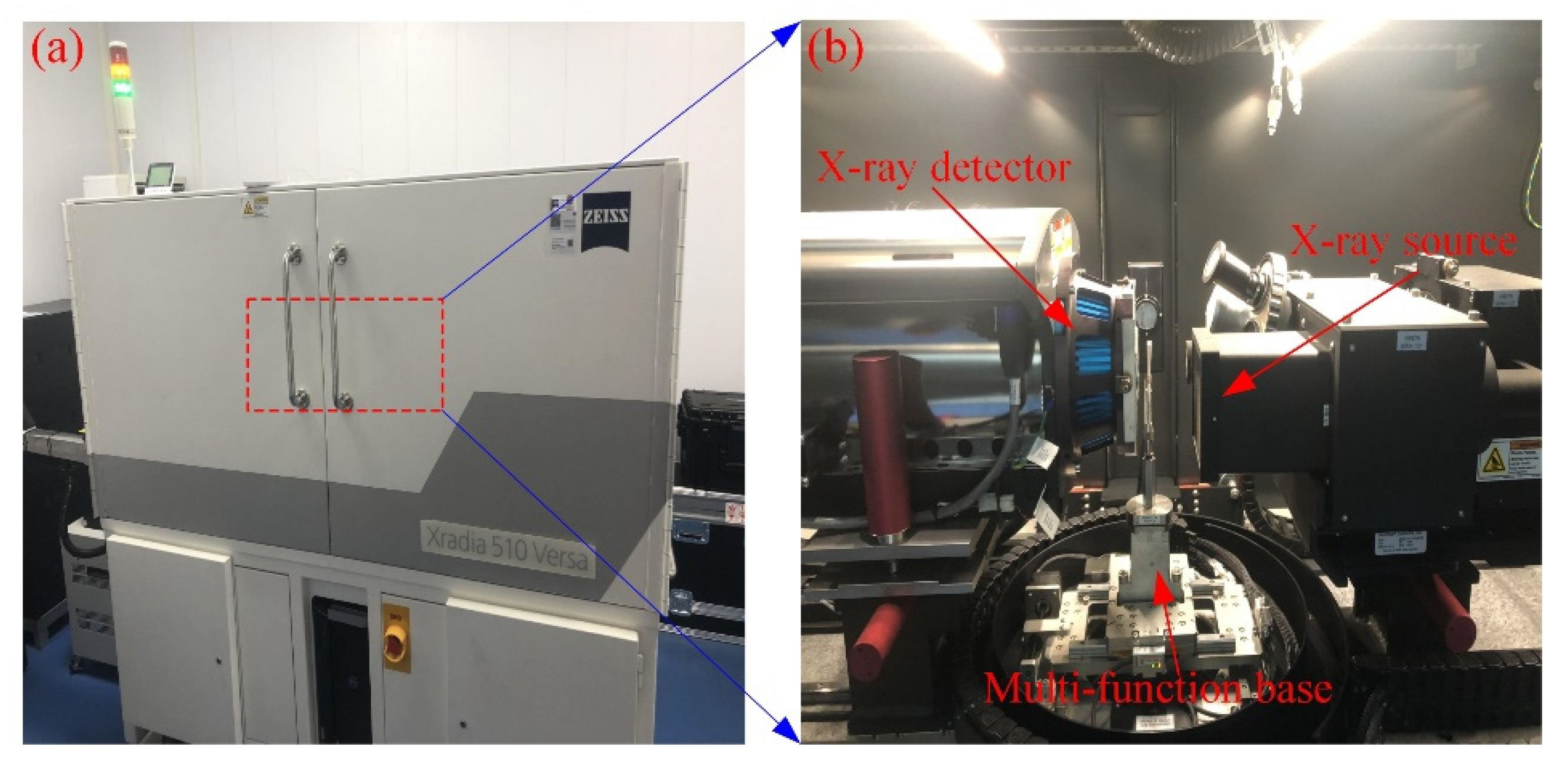
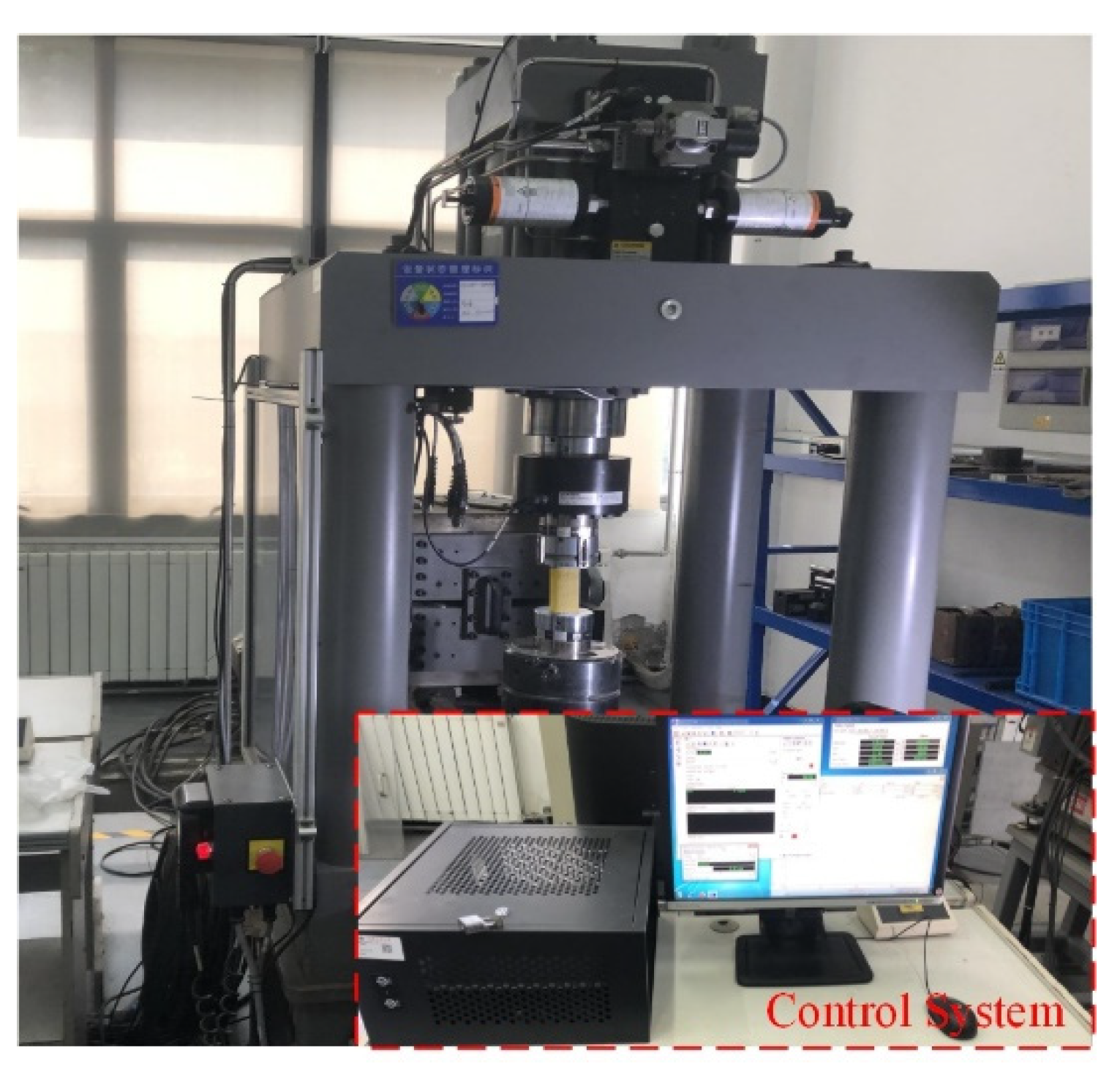
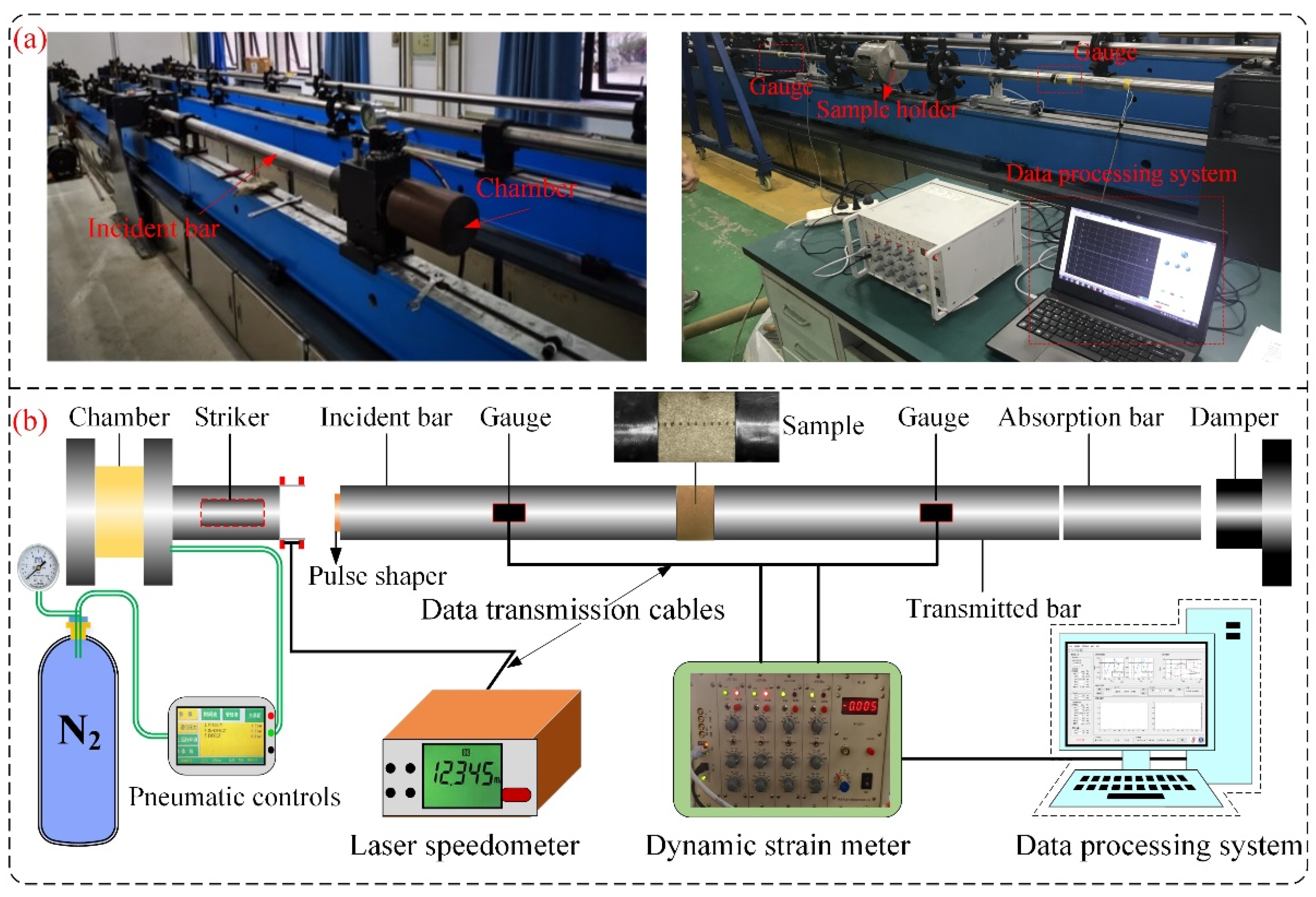

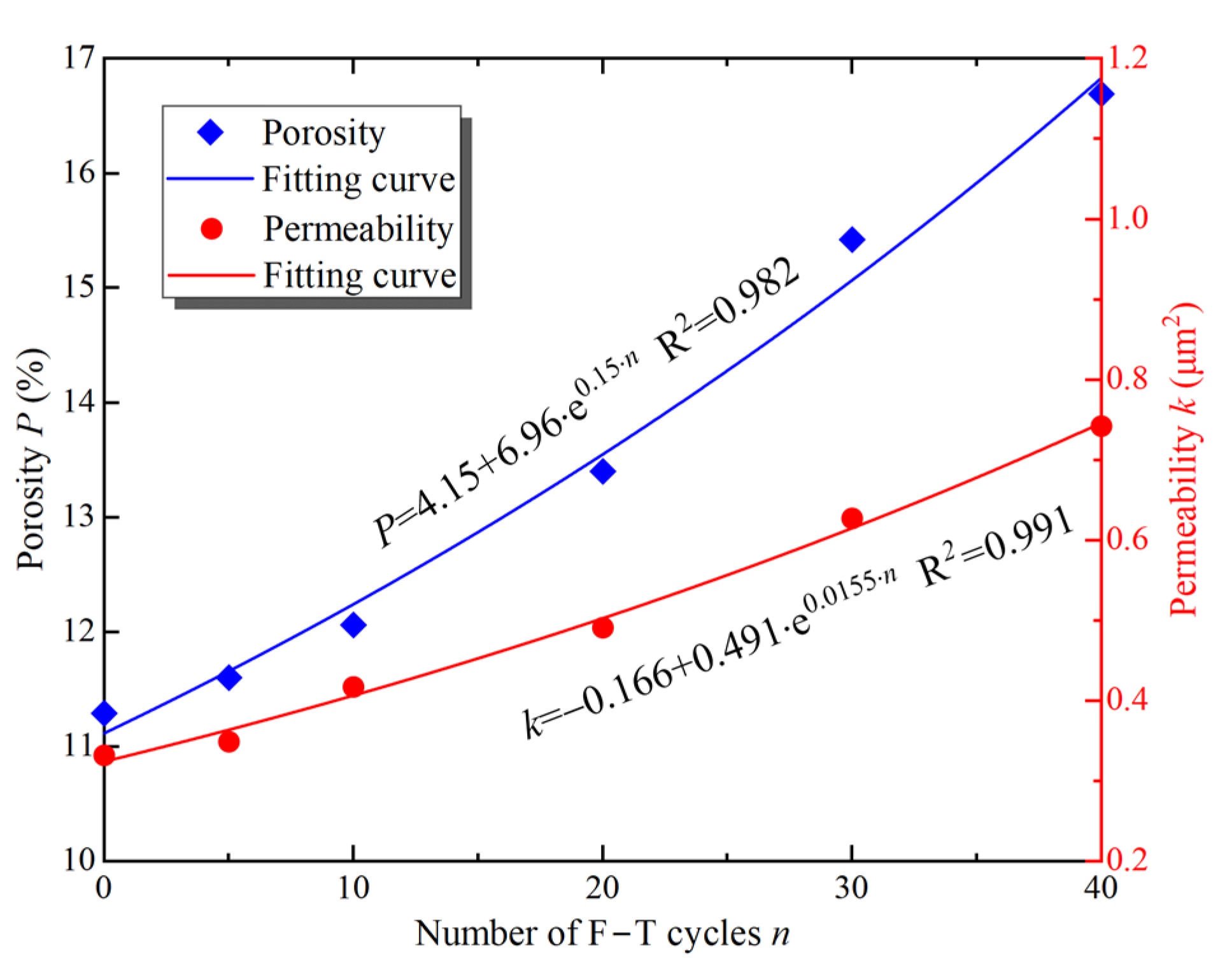
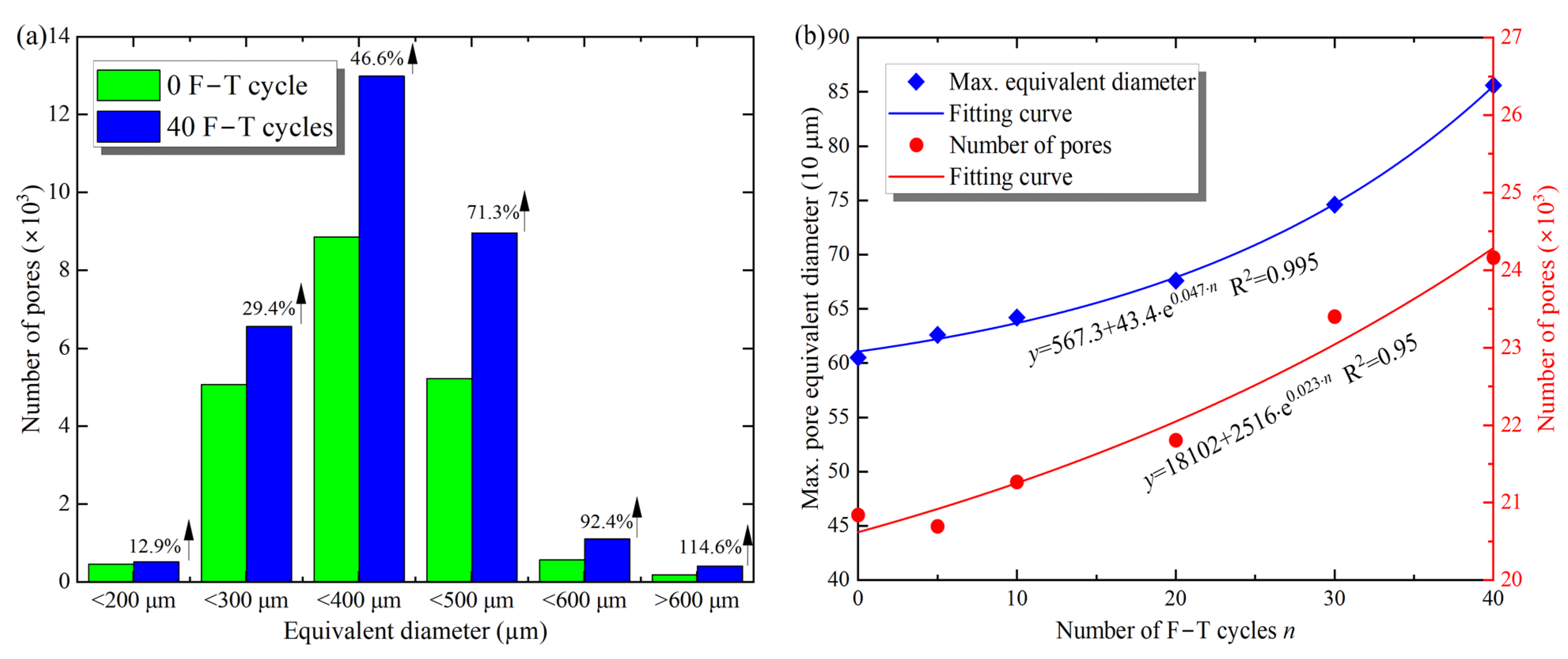
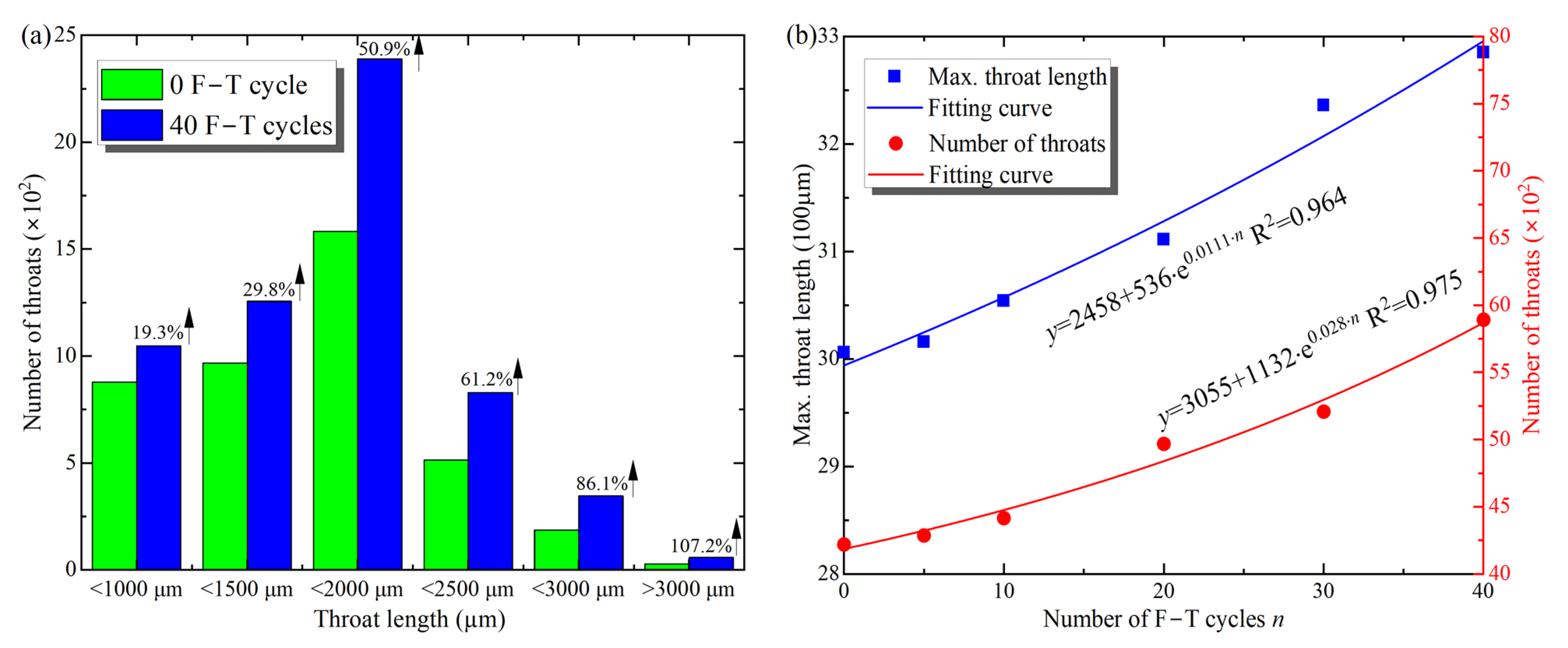



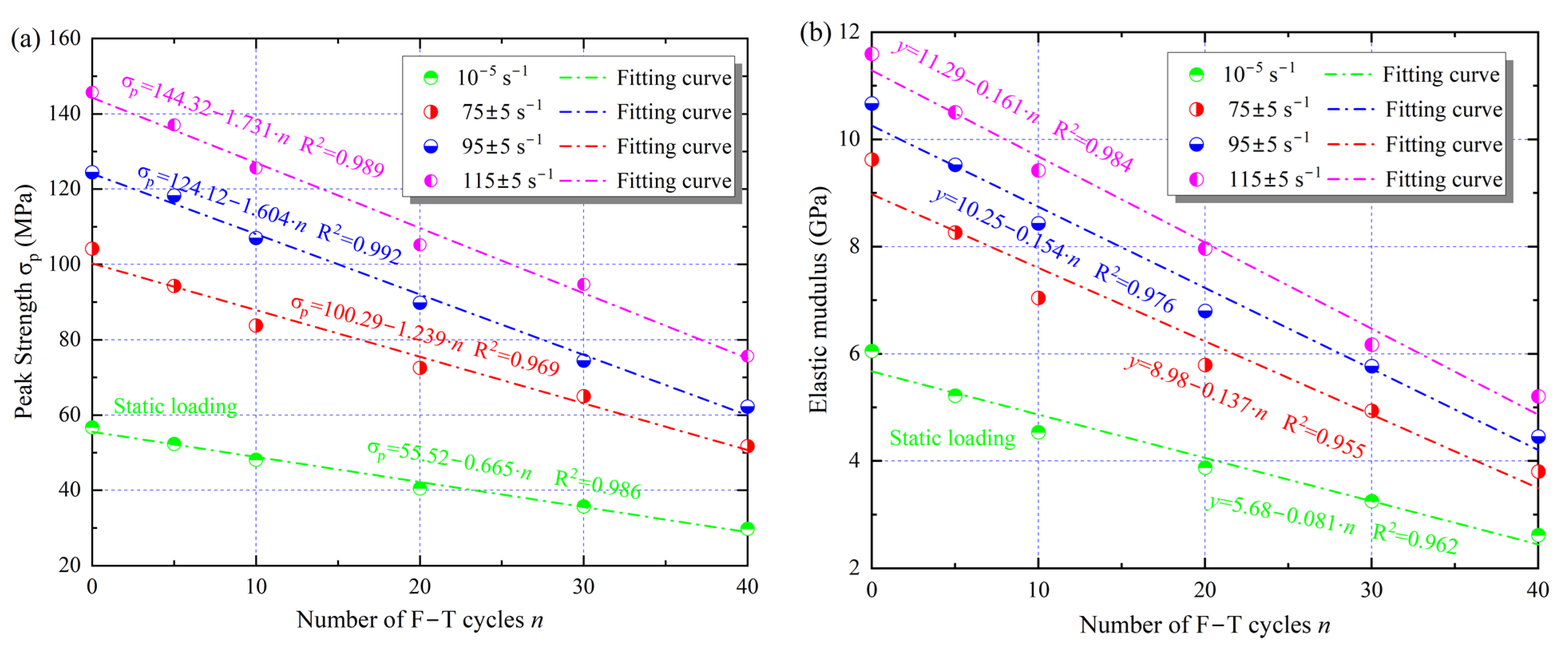
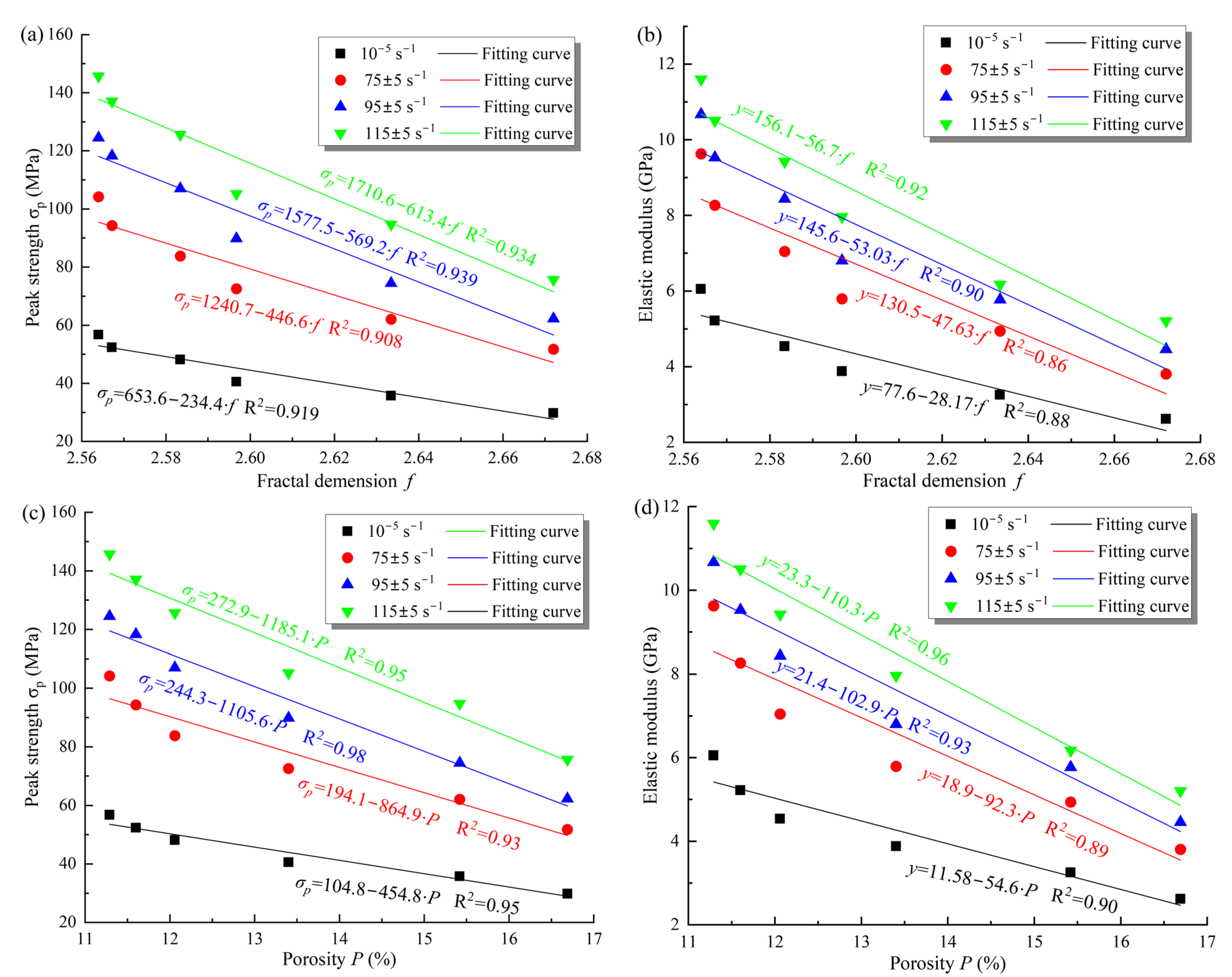
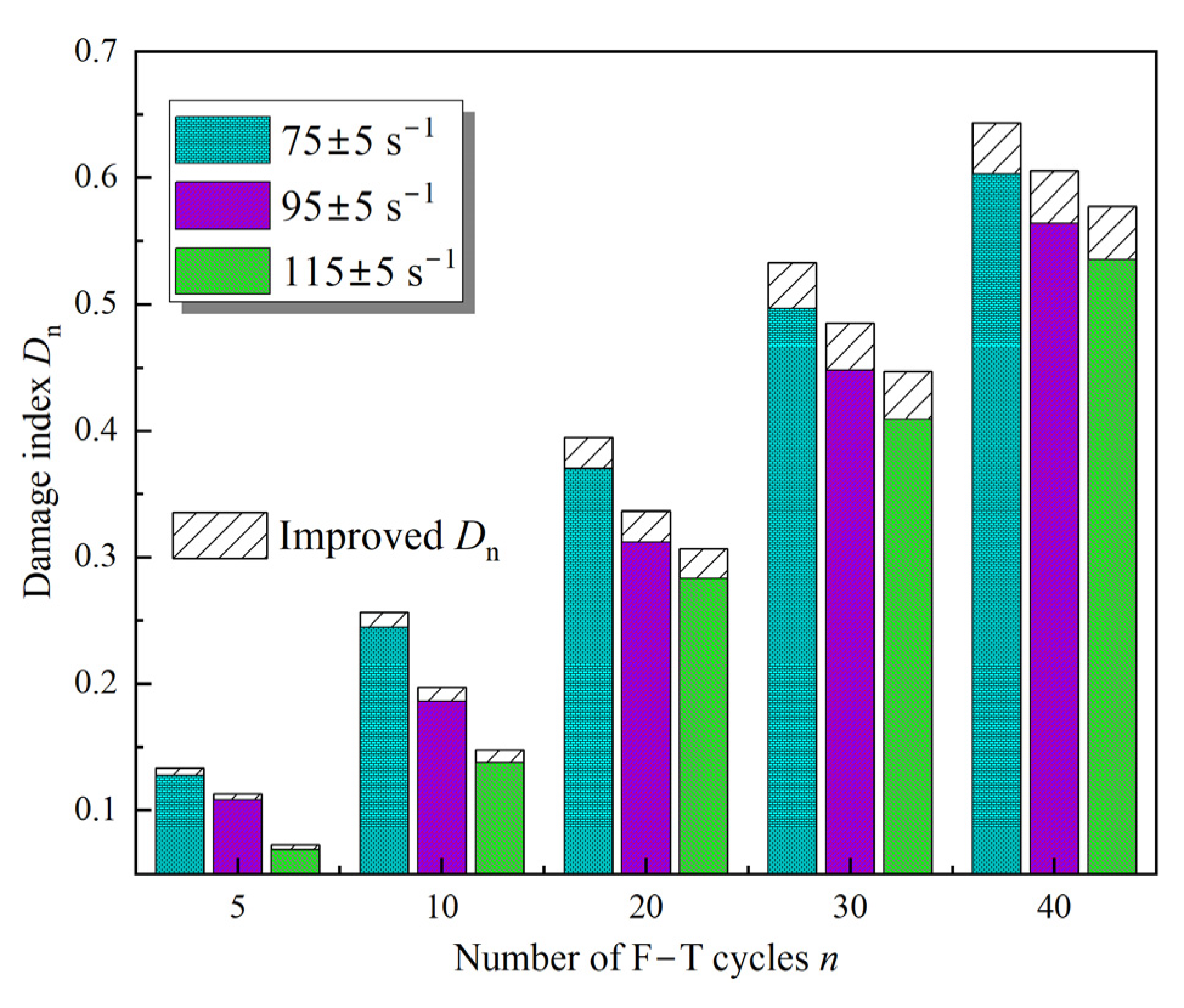


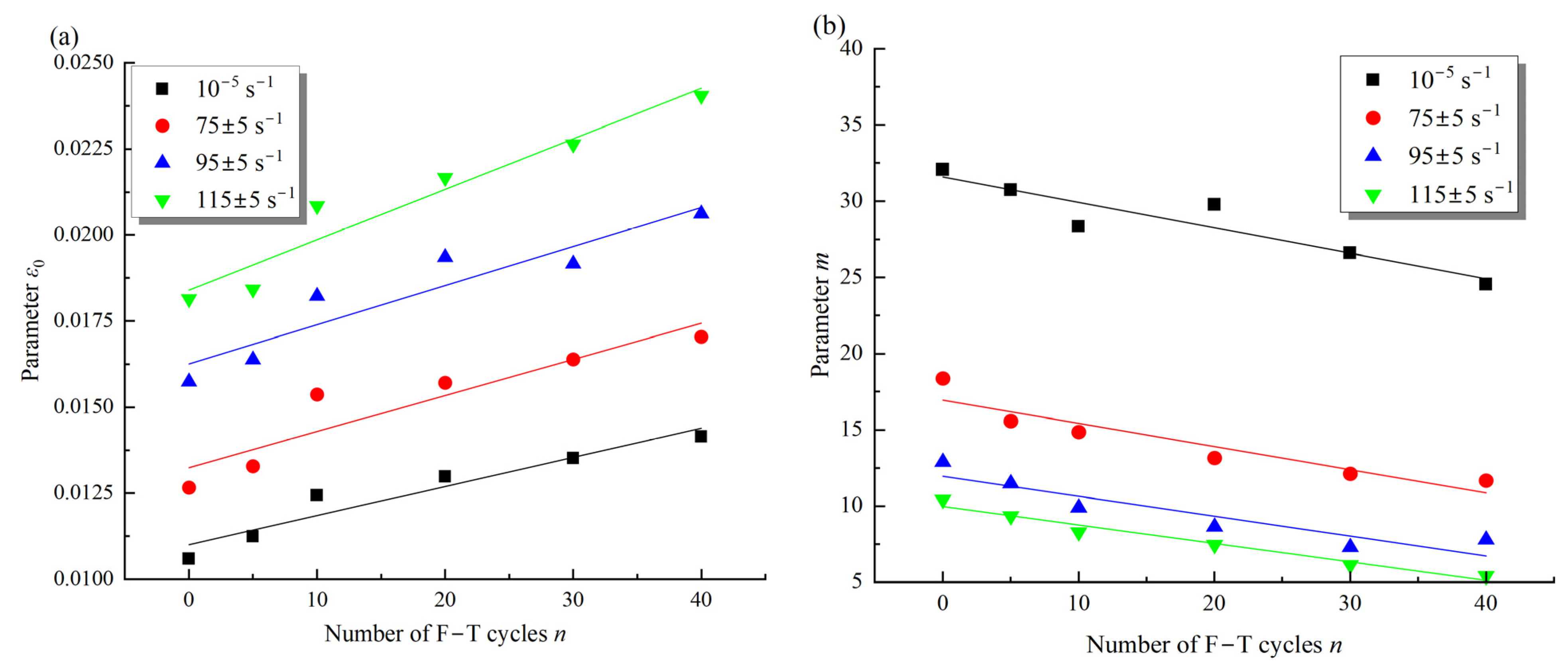
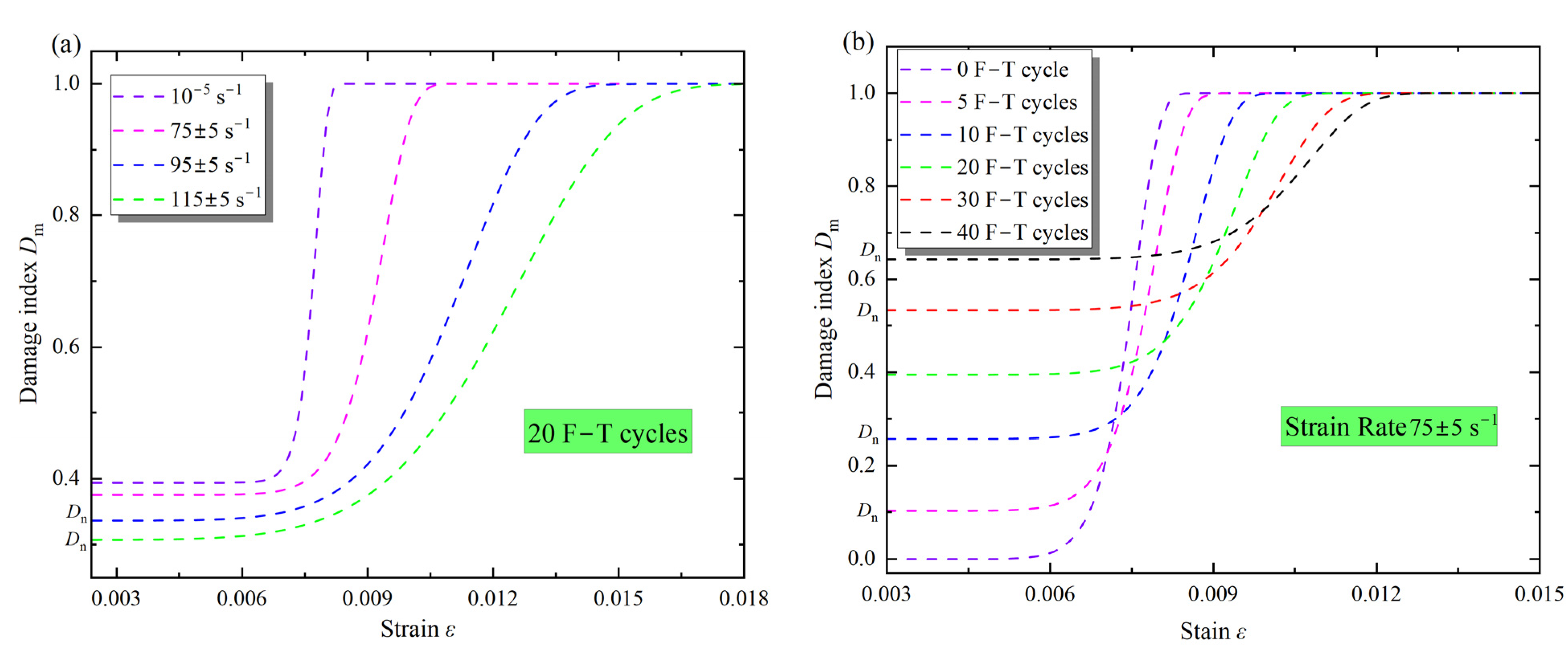
| Vp (km/s) | ρd (g/cm3) | ρsat (g/cm3) | n (%) | σp (MPa) |
|---|---|---|---|---|
| 2623 | 2.14 | 2.27 | 11.3 | 58.7 |
| Voltage (kV) | Current (μA) | Exposure Time (s) | Resolution (μm) | The Number of Scan Images |
|---|---|---|---|---|
| 100 | 90 | 5 | 20 | 1100 |
Disclaimer/Publisher’s Note: The statements, opinions and data contained in all publications are solely those of the individual author(s) and contributor(s) and not of MDPI and/or the editor(s). MDPI and/or the editor(s) disclaim responsibility for any injury to people or property resulting from any ideas, methods, instructions or products referred to in the content. |
© 2022 by the authors. Licensee MDPI, Basel, Switzerland. This article is an open access article distributed under the terms and conditions of the Creative Commons Attribution (CC BY) license (https://creativecommons.org/licenses/by/4.0/).
Share and Cite
Xu, J.; Pu, H.; Sha, Z. Influence of Microstructure on Dynamic Mechanical Behavior and Damage Evolution of Frozen–Thawed Sandstone Using Computed Tomography. Materials 2023, 16, 119. https://doi.org/10.3390/ma16010119
Xu J, Pu H, Sha Z. Influence of Microstructure on Dynamic Mechanical Behavior and Damage Evolution of Frozen–Thawed Sandstone Using Computed Tomography. Materials. 2023; 16(1):119. https://doi.org/10.3390/ma16010119
Chicago/Turabian StyleXu, Junce, Hai Pu, and Ziheng Sha. 2023. "Influence of Microstructure on Dynamic Mechanical Behavior and Damage Evolution of Frozen–Thawed Sandstone Using Computed Tomography" Materials 16, no. 1: 119. https://doi.org/10.3390/ma16010119









